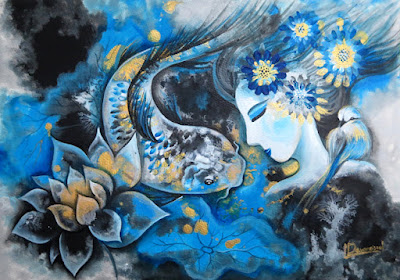April 18 (Lunar calendar: Leap February 28), 2023 Tuesday | Dawnxisoul393art
Thoughts after Rewatching the Film" Big Eyes":
Today, we rewatched the biopic "Big Eyes" released at the end of 2014 and early 2015. In the gradual process, director Tim Burden let the drama highlighted be slowly condensed and distributed through the evolution of the story. The whole story was full of drama. The performance of the film actors made the audiences' emotions accumulated slowly and sublimated completely through the finally condensed compassion. The husband didn't understand his wife's paintings, they were a tool for him to make money, so he didn't respect them. A relationship between husband and wife, a love wrapped in sugar paper. Three times in the film, the wife Margaret held her daughter's hand behind her back. Without too many words, her eyes and strength have poured into expressing all her emotions. A successful film is described, inspires the audience to think.
Wife Margaret, a female painter who liked to create quietly, met Walter with her paintings. Walter tried to sell the painting in every way possible, and one day, his pompous sales pitch first paid off as he held a large handful of American dollars to scatter on the Margaret. Margaret, who was overwhelmed by the victory, was also excited about the success of the sales pitch. After the ecstasy was always accompanied by a little sadness. Margaret spent her days in the dark studio and had to hide from her daughter to keep her from finding out the truth. People who understand art have multiple feelings. It is because they attach too much importance to feel that they will be completely hurt her feelings. Intending to "start over" again, Margaret found a new place to live with her daughter, and her life was restored to sunshine. However, Walter still kept harassing her and asking her for paintings. Margaret was like a moth, not hitting the wall and not turning back to the fire, and finally, she hit the wall and woke up only when she was bruised. When we saw this movie, we could easily feel sympathy for Margaret.
The director has mastered the ability to shape the plot to play with the film's ability to distinguish right from wrong, using clever linear analysis to create a sympathetic Margaret. The director escalated the interpretation of the emotions brought by the film to the maximum. Not only did the film's plot make a biographical film calm and comfortable, but it also made the entire film powerful by directing the actors' performances. The director kept his ideas in mind in his personal style, and even in a moderately orthodox film, he was able to reflect his mastery with ease. Margaret's eyes and the tears in the corners of her eyes were just the right amount of acting to blend into the entire plot, and even though there was not much physical performance, it truly reflected the strong quality of a single mother. Big Eyes was a visual metaphor that gave us a little more "drama" when we looked at the film.
Perhaps this "drama" was not in the film itself but was reflected in our perception of this real event. Such "drama" was also present in the scene where the hero and heroine went to court together. This scene, which seemed to have some significance to us, ends in a bland and comedic way. This scene was also the end of the film, which was based on real events. The movie seemed to tell us that this was Margaret's way of letting go of this dark experience that happened to her. If this was really what Margaret thought, we should be happy for her to get out of this psychological shadow. There are some black-and-white scenes of Walter in the movie, which depicted the social achievements of Walter in that era. Before the film was released, Walter had passed away. In a way, the director also made these black and white scenes in the film have some special meaning.
Illustrated by dawnxisoul393
At the beginning of the film, we were drawn to the bright, highly saturated colors on the screen. These romantic colors also appeared in the initial romantic moments of the hero and heroine, as well as in the scenes after she left home for the second time. In the process of meeting, falling in love with, and marrying Walter, it is Margaret's inner struggle to break out of this social environment for the first time. The eyes of the actress who plays Margaret were so beautiful that, although the title of the film had nothing to do with the eyes of Margaret, the actress's eyes seemed to speak, which was perfect for such an aggrieved role. A cursory look at the story seemed to be a criticism of the man's oppression of his wife, fraudulent buyers, shamelessly bad behavior, but in fact, it was a criticism of the era. When the heroine first moved to San Francisco, she used to paint for others in the park for only two dollars each, but compared to the bustle of other painters around her, her place was cold and quiet.
Finally, when someone asked for a painting, the man was only willing to pay a dollar, However, a small landscape painting of Walter next to it could sell for $35. Before the mid-20th century, the status of female artists was very small. No one would buy female works of art. This was the grievance of women, the sadness of art, and the fault of the times. Art should not be divided by gender, and there was no basis for the art market differentiated by gender. We love a work of art because we love the story behind it, its color, its style, and its connotation, not because it was created by men or women. Until Margaret met Walter. Walter especially appreciated her paintings and seemed to like her a little. As a single mother, Margaret resonated with Walter. Walter used his flexible business mind to vigorously promote Margaret's paintings, which also enhanced Margaret's love for Walter.
Illustrated by dawnxisoul393
But in the days after marrying Walter, Margaret found that Walter actually exploited her creative efforts by marrying her. And so a rights lawsuit was fought. But Margaret was not good at words, naturally, in the words of the fight could not be clever Walter. In order to verify the truth of the case, the judge asked Walter and Margaret to make a painting on the spot. Walter only kept finding excuses to shirk, until the end of the painting time. Margaret, with her solid skills, completed a complete painting on the spot within the time limit. Facts speak louder than words. Margaret finally used her own talent and perseverance to defend her rights and won due respect for her fellow women who were ignored. Perhaps it was this perseverance and belief that infected Tim Burden, who also loved art, that led to this film. Although there was still a long way to go before true equality between men and women, more and more women artists were leaving their names in history.
Tim Burden is one of the most imaginative and innovative filmmakers, with a fantastical and passionate imagination and a unique visual style. At the same time, he is a Hollywood alternative genius whose work has enchanting magic. His ornate gothic style is one of his most celebrated characteristics. Relying on exaggerated colors, quirky characters and different styles of costumes, his works have time and again touched our hearts. The film "Big Eyes" is a biopic directed by Tim Burden, but we have the impression that it does not inherit his unique style of a gothic form, Tim Burden directed the film through the most common way of filming, so that the film artwork without the stylization, more reflect its far-reaching influence and artistic value. We usually only see the grotesque magic in Tim Burden's works, but in fact, his works have a commonality, which is the almost paranoid pursuit of spirituality.
Original by dawnxisoul393,
Thoughts after Rewatching the Film"Big Eyes",Dawnxisoul393












Comments
Post a Comment